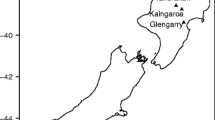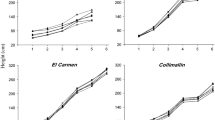Abstract
Key message
In Tachigali vulgaris planting, the 3.0 × 3.0 m spacing reduced variability in wood properties and increased the proportion of medium-density wood, while forking increased the proportion of low-density wood.
Abstract
Promising Amazonia species for forest energy crops require further investigation into how silviculture affects wood quality. This study sought to investigate how planting spacing and stem type (forked and non-forked) affect the basic wood density, X-ray density, and heartwood development of Tachigali vulgaris in a homogeneous plantation in Amazonia. The experiment was established with initial planting spacings of 3.0 × 1.5 m, 3.0 × 2.0 m, 3.0 × 2.5 m, 3.0 × 3.0 m, 3.0 × 3.5 m, and 3.0 × 4.0 m. 102-month-old trees were harvested for the work. Disks sampled along the stem height were tested for wood basic density and density measured by X-ray densitometry (air-dry density by growth ring) analyses. Disks obtained at the 1.3 m height were photographed and submitted to image manipulation for heartwood/sapwood analysis. The lowest average wood density was 0.512 g cm−3 in the 3.0 × 1.5 m spacing, and the highest was 0.538 g cm−3 in the 3.0 × 4.0 m spacing. Among non-forked trees, 66% had medium-density (≥ 0.500 g cm−3) and 34% low-density (< 0.500 g cm−3) wood. In contrast, forked trees had only 55% of trees with medium-density wood. The X-ray density profiles reduced from 0.713 to 0.582 g cm−3 in the increasing longitudinal direction and from 0.393 to 0.973 g cm−3 in the radial direction. Forking did not influence the heartwood proportion (60.03–61.54%). The 3.0 × 3.0 m spacing favored the wood quality concerning density class and variability, while the widest spacings improved heartwood formation. The forking increases the chances of low-density wood and its variations along the stem. Thus, future genetic studies should focus on this phenomenon to increase the productivity of Tachigali vulgaris energy forests.







Similar content being viewed by others
Data availability
Datasets that support the conclusions are included in the manuscript. In addition, the datasets analyzed in this research are available from the corresponding author upon request.
References
ABNT (2003) Associação Brasileira de Normas Técnicas. NBR 11941: Madeira - determinação da densidade básica. Rio de Janeiro
Almeida MNF, Vidaurre GB, Pezzopane JEM et al (2020) Heartwood variation of Eucalyptus urophylla is influenced by climatic conditions. For Ecol Manag 458:117743. https://doi.org/10.1016/j.foreco.2019.117743
Amorim P, Morgado R, Espada ALV, et al (2010) Economic-environmental diagnosis of the municipality of Almeirim, Pará. Instituto Floresta Tropical, Belém
Baettig R, Cornejo J, Guajardo J (2017) Evaluation of intra-ring wood density profiles using NIRS: comparison with the X-ray method. Ann for Sci 74:13. https://doi.org/10.1007/s13595-016-0597-7
Balboni BM, Batista AS, Garcia JN (2021) Evaluating the potential for timber production of young forests of Eucalyptus spp. clones used for bioenergy: wood density and mechanical properties. Aust for 84:122–132. https://doi.org/10.1080/00049158.2021.1945238
Barros-Junior U, Rosário W, Lima M et al (2022) Effects of tree spacing and forking on the modification of wood density in a trial plantation of Tachigali vulgaris for energy in Amazonia. J Trop for Sci 34:11–23. https://doi.org/10.26525/jtfs2022.34.1.11
Batista A, Calmon M, Lund S, et al (2021) Investimento em reflorestamento com espécies nativas e sistemas agroflorestais no Brasil: uma avaliação econômica. WRI Brasil
Boschetti WTN, Paes JB, Vidaurre GB et al (2015) Dendrometric parameters and eccentricity of the pith in leaning eucalypt trees. Sci for 43:781–789. https://doi.org/10.18671/scifor.v43n108.4
Boschetti WTN, Pereira MPCF, Soratto DN et al (2017) Properties of charcoal produced from reaction wood in trees inclined due to wind. Revista Árvore 41:e410601. https://doi.org/10.1590/1806-90882017000600001
Brazil Steel Institute (2021) Steel statistics. Rio de Janeiro
Brienen RJW, Schöngart J, Zuidema PA (2016) Tree rings in the tropics: insights into the ecology and climate sensitivity of tropical trees. In: Goldstein G, Santiago L (eds) Tropical tree physiology. Tree physiology, vol 6. Springer, Cham. https://doi.org/10.1007/978-3-319-27422-5_20
Briseño-Uribe KC, Carrillo-Parra A, Bustamante-García V et al (2015) Firewood production, yield and quality of charcoal from Eucalyptus camaldulensis and E. microtheca planted in the semiarid land of northeast Mexico. Int J Green Energy 12:961–969. https://doi.org/10.1080/15435075.2014.891121
Brito A, Vidaurre G, Oliveira J et al (2021) Interaction between planting spacing and wood properties of Eucalyptus clones grown in short rotation. Iforest 14:12–17. https://doi.org/10.3832/ifor3574-013
Carneiro ACO, Castro AFNM, Castro RVO et al (2014) Potential energy of Eucalyptus sp. wood according to age and different genetic materials. Árvore 38:375–381
Carvalho PER (2005) Taxi-branco: taxonomy and nomenclature. Embrapa Florestas, Colombo
Costa SEL, Santos RC, Vidaurre GB et al (2020) The effects of contrasting environments on the basic density and mean annual increment of wood from eucalyptus clones. For Ecol Manage 458:117807. https://doi.org/10.1016/j.foreco.2019.117807
Dias Júnior AF, Pincelli ALMS, Câmara da Silva AP et al (2021) Integrating species and successional classes for wood production in a mixed forest restoration system in a neotropical region. J for Res (harbin) 32:2313–2321. https://doi.org/10.1007/s11676-021-01297-w
Ferreira EB, Cavalcanti PP, Nogueira DA (2021) ExpDes: experimental designs pacakge. R package version 1.2.2
Gimp Development Team (2019) GIMP 2.10.2. USA. Available from: https://www.gimp.org. Accessed 20 Mar 2022
Gomes IRF, dos Santos RC, Castro RVO et al (2021) Does spacing affect the production of clones for wood energy planted in the state of Rio Grande do Norte, Brazil? Sci for 49:e3641. https://doi.org/10.18671/scifor.v49n131.25
Gominho J, Pereira H (2005) The influence of tree spacing in heartwood content in Eucalyptus globulus Labill. Wood Fiber Sci 4:582–590
IBÁ-Brazilian Tree Industry (2022) IBÁ annual report 2022. IBÁ, São Paulo
IBGE - Brazilian Institute of Geography and Statistics (2020) Agricultural aptitude map of the State of Pará. IBGE
Jacquin P, Longuetaud F, Leban J-M, Mothe F (2017) X-ray densitometry of wood: a review of existing principles and devices. Dendrochronologia (verona) 42:42–50. https://doi.org/10.1016/j.dendro.2017.01.004
Knapic S, Pirralho M, Louzada JL, Pereira H (2014) Early assessment of density features for 19 Eucalyptus species using X-ray densitometry in a perspective of potential biomass production. Wood Sci Technol 48:37–49. https://doi.org/10.1007/s00226-013-0579-y
Lima MDR, Massuque J, Bufalino L et al (2022a) Clarifying the carbonization temperature effects on the production and apparent density of charcoal derived from Amazonia wood wastes. J Anal Appl Pyrolysis 166:105636. https://doi.org/10.1016/j.jaap.2022.105636
Lima MDR, Moraes LG, Silva RCC et al (2022b) Tachigali vulgaris energy forests: understanding spacing, age, and stem type effects on tree growth patterns and wood density. New for (dordr). https://doi.org/10.1007/s11056-022-09932-y
Magalhães LGS, Lima APL, Lima SF et al (2020) Basic density of wood of eucalyptus clones in different spacing. Braz J Dev 6:19435–19445. https://doi.org/10.34117/bjdv6n4-202
Martinez-Meier A, Fernández ME, Dalla-Salda G et al (2015) Ecophysiological basis of wood formation in ponderosa pine: linking water flux patterns with wood Air-dry density variables. For Ecol Manag 346:31–40. https://doi.org/10.1016/j.foreco.2015.02.021
Moraes LG, Assis-Pereira G, Protásio TP et al (2022) Dendrochronology and X-ray densitometry applied to the evaluation of the wood properties of Tachigali vulgaris trees. In: Reis CAF, Gonçalves DA, Protásio TP (eds) Tachigalis vulgaris Forests, 1st edn. Embrapa Florestas, Colombo, pp 99–112
Moulin JC, Arantes MDC, Oliveira JGL et al (2017) Effect of spacing, age and irrigation on the volume and basic density in Eucalyptus. Floresta e Ambiente 24:1–10. https://doi.org/10.1590/2179-8087.073914
Moya R, Tomazello Filho M (2009) Wood density variation and tree ring demarcation in Gmelina arborea trees using X-ray densitometry. Cerne 15:92–100
Oliveira I, Chagas M, Bouillet J et al (2018) Effect of tree spacing on growth and wood density of 38-year-old Cariniana legalis trees in Brazil. South for 80:311–318. https://doi.org/10.2989/20702620.2017.1393741
Omonte M, Valenzuela L (2011) Radial and longitudinal basic density variation in 16 years old Eucalyptus regnans trees. Maderas Ciencia y Tecnología 13:211–224. https://doi.org/10.4067/S0718-221X2011000200009
Palermo GPM, Latorraca JVF, Carvalho AM et al (2015) Anatomical properties of Eucalyptus grandis wood and transition age between the juvenile and mature woods. Eur J Wood Wood Prod 73:775–780. https://doi.org/10.1007/s00107-015-0947-4
Pereira BLC, Oliveira AC, Carvalho AMML et al (2013) Correlations among the heart/sapwood ratio of eucalyptus wood, yield and charcoal properties. Sci for 41:217–225
Protásio TP, Lima MDR, Scatolino MV et al (2021) Charcoal productivity and quality parameters for reliable classification of Eucalyptus clones from Brazilian energy forests. Renew Energy 164:34–45. https://doi.org/10.1016/j.renene.2020.09.057
QGIS Development Team (2020) QGIS Geographic Information System 3.14.15. Open Source Geospatial Foundation Project. Available from: http://qgis.osgeo.org. Accessed 20 Mar 2022
R Core Team (2021) R: a language and environment for statistical computing. R Foundation for Statistical Computing, Vienna
Rinker T, Kurkiewicz D, Hughitt K, et al (2019) pacman: package management tool. R package version 0.5.1
Rodrigues T, Braghini Junior A (2019) Charcoal: a discussion on carbonization kilns. J Anal Appl Pyrolysis 143:104670. https://doi.org/10.1016/j.jaap.2019.104670
Rodrigues JC, Fujimoto T, Schwanninger M, Tsuchikawa S (2013) Prediction of wood density using near Infrared-Based partial least squares regression models calibrated with X-Ray microdensity. NIR News 24:4–8. https://doi.org/10.1255/nirn.1352
Rodrigues RP, Gonçalves DA, Silva AR et al (2020) Growth and mortality of Tachigali vulgaris L. G. Silva and H. C. Lima in different planting spacing for biomass production. Sci for 48:1–11. https://doi.org/10.18671/scifor.v48n128.01
Ruiz-Aquino F, Ruiz-Ángel S, Santiago-García W et al (2019) Energy characteristics of wood and charcoal of selected tree species in Mexico. Wood Res 64:71–82
Santos LMH, Almeida MNF, Silva JGM et al (2021) Variations in heartwood formation and wood density as a function of age and plant spacing in a fast-growing eucalyptus plantation. Holzforschung 75:979–988. https://doi.org/10.1515/hf-2020-0215
Schimleck L, Antony F, Mora C, Dahlen J (2018) Comparison of whole-tree wood property maps for 13- and 22-Year-old loblolly pine. Forests 9:287. https://doi.org/10.3390/f9060287
Silva MOS, Silva MG, Bufalino L et al (2021) Variations in productivity and wood properties of Amazonian tachi-branco trees planted at different spacings for bioenergy purposes. J for Res (harbin) 32:211–224. https://doi.org/10.1007/s11676-019-01068-8
SINDIFER. Sindicato da Indústria do Ferro no Estado de Minas Gerais (2021) Pig iron production in Minas Gerais and in Brazil. Statistical yearbook reference: 2020. Minas Gerais
Tomazello M, Brazolin S, Chagas MP et al (2008) Application of x-ray technique in non-destructive evaluation of eucalypt wood. Maderas Ciencia y Tecnología 10:139–149. https://doi.org/10.4067/S0718-221X2008000200006
Tonini H, Schwengber DR, Morales MM, Oliveira JMF (2018) Growth and wood energy quality of Tachigali vulgaris in different spacing. Pesqui Florest Bras 38:1–8. https://doi.org/10.4336/2018.pfb.38e201801569
Torres CMME, Oliveira AC, Pereira BLC et al (2016) Estimates of production and properties of eucalyptus wood in Agroforestry Systems. Sci for 44:137–148. https://doi.org/10.18671/scifor.v44n109.13
Wickham H, Averick M, Bryan J et al (2019) Welcome to the Tidyverse. J Open Source Softw 4:1686. https://doi.org/10.21105/joss.01686
Acknowledgements
The authors are grateful to the National Council for Scientific and Technological Development (CNPq; process no. 306793/2019-9), Coordination for the Improvement of Higher Education Personnel of Education (CAPES; funding codes 001, no. 88887.512868/2020-00, and Edital Procad Amazônia 2018—process no. 88881.199859/2018-01), Embrapa Amazônia Oriental, and Grupo Jari Celulose S.A, for funding the execution of this study.
Funding
This study received financial support for the logistics activities of collecting and transporting material from the Federal Rural University of Amazonia, Embrapa Eastern Amazonia, Jari Celulose S.A, and Coordination for the Improvement of Higher Education Personnel (Edital Procad Amazônia 2018—process no. 88881.199859/2018–01). The author Larissa Gonçalves Moraes received research support from the Coordination for the Improvement of Higher Education Personnel (CAPES; funding codes 001, no. 88887.512868/2020-00, and Procad Amazônia 2021—processes no. 88887.642042/2021-00 and no. 88887.597095/2021-00).
Author information
Authors and Affiliations
Corresponding author
Ethics declarations
Conflict of interest
The authors have no relevant financial or non-financial interests to disclose.
Additional information
Communicated by Inoue.
Publisher's Note
Springer Nature remains neutral with regard to jurisdictional claims in published maps and institutional affiliations.
Rights and permissions
Springer Nature or its licensor (e.g. a society or other partner) holds exclusive rights to this article under a publishing agreement with the author(s) or other rightsholder(s); author self-archiving of the accepted manuscript version of this article is solely governed by the terms of such publishing agreement and applicable law.
About this article
Cite this article
Moraes, L.G., Lima, M.D.R., Assis-Pereira, G. et al. Forking and planting spacing impacts on wood density, X-ray density, and heartwood proportion of Tachigali vulgaris. Trees 37, 1567–1581 (2023). https://doi.org/10.1007/s00468-023-02443-z
Received:
Accepted:
Published:
Issue Date:
DOI: https://doi.org/10.1007/s00468-023-02443-z




